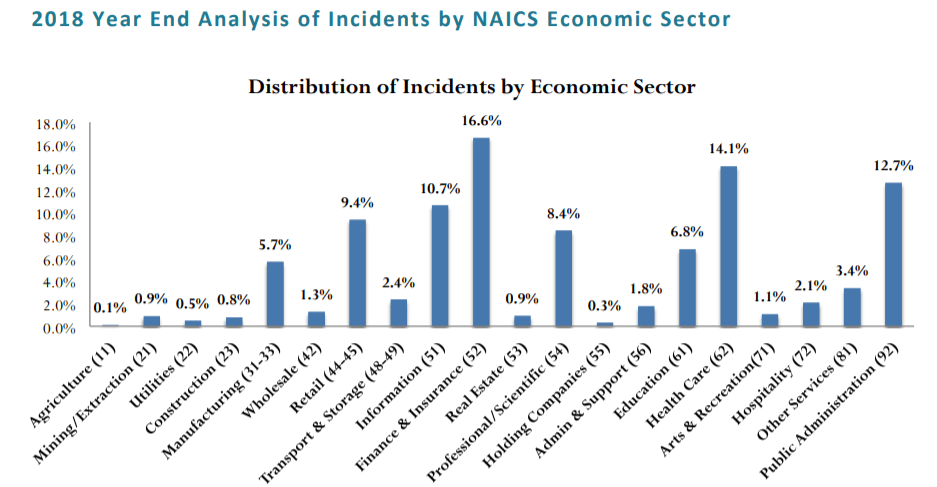
Constant Data Breaches expected throughout 2019
2018 Was Second-Most Active Year for Information Data Breaches. Hacking by external actors triggered most security breaches, however, Web invasions and exposures compromised more records. More than 6,500 security breaches were reported in 2018, according to a brand-new report from Risk Based Security shows.
The breaches, both big and little, were reported through Dec. 31, 2018 - marking a 3.2% decline from the 6,728 breaches reported in 2017 and making it the second-most active year for data breaches on record. Some 5 billion records were exposed, or about 36% less than the nearly 8 billion records exposed in breaches in 2017. In addition, more records were compromised last year than in any previous year, except in 2017 and 2005.

Our only security is our ability to change. ~ John Lilly
As has been the case previously, a handful of mega breaches accounted for a large proportion of the jeopardized records. In 2018, the 10 biggest breaches accounted for around 3.6 billion exposed records - or a shocking 70% of the overall. In all, 12 breaches in 2018 exposed at least 100 million records. Organizations that disclosed the biggest breaches last year included Facebook, Under Armor, Starwood Hotels, and Quora. For a large bulk of breaches, however, the variety of exposed records was 10,000 or less.
The medical and education sectors, frequently denigrated for having bad security, paradoxically exposed far fewer records than other supposedly more safe and secure sectors. Risk Based Security's analysis shows that financial service companies, innovation companies, merchants, restaurants, hotels, and other organisations were accountable for nearly 66% of the reported data breaches and a near similar proportion of the records that were exposed last year. In contrast, the medical and education sectors integrated exposed less than 10 million records.
More than 6 in 10 of the breaches exposed e-mail addresses and about 57% also involved passwords. The proportion of breaches that exposed Social Security numbers and credit card numbers - the two most valuable pieces of data for wrongdoers - was rather smaller on the other hand, at 13.9% and 12.3%, respectively.
Risk Based Security's report shows that hacking by destructive external actors stayed the cause for the majority of information breaches (57.1%), but Web breaches, such as those resulting from intrusions and data publicly accessible through an online search engine, exposed more records (39.3%). Insider breaches - of the unexpected, negligent, and destructive variety - accounted for about 14% of all breaches since 2015.
Protect your WordPress: BEFORE IT'S TOO LATE! You will also protect your customers, your reputation and your online business!
Disclosure of Data Breaches:
One surprise in the information was the minimal development that companies appear to be making in closing the gap in between breach discovery and breach disclosure, explains Inga Goddijn, executive vice president at Risk Based Security.
The data reveals that government and personal organizations took approximately 49.6 days in 2015 to openly report a breach after its initial discovery. That was actually marginally longer than the 48.6 days it took in 2017, suggesting that companies are struggling to accelerate event response in spite of the increased pressure on them to do so in the last few years.
"What we found was, after three years of closing the gap in between discovery and reporting, the typical variety of days in between those 2 dates was stagnant in 2018", Goodijn says.
The basic anticipation was that safety requirements such as the European Union's GDPR Guideline would put pressure on business companies to enhance breach disclosure times. So it was surprising to see little motion on that front last year. "It's hard to say why it is still taking almost 50 days to reveal a breach", Goodijn notes. "It could be we have reached a plateau, where it just takes two to three weeks to perform a complete examination and another two to three weeks to work through preparing and releasing a notice".
The GDPR also has a clear difference between divulging a breach to authorities and alerting victims about it, Goddijn states. The required needs breach entities to inform data regulators in their jurisdictions about the event within 72 hours. However, it offers some discretion around when and even whether a company requires to inform those impacted by a breach. "So even if an occasion is swiftly reported to privacy regulators, it is possible the event will be publicly divulged weeks later, if at all", Goddijn says.
Risk Based Security's report does not include "dwell time", or the period in between when an assailant first burglarizes a network and when the invasion is very first found. However, it does show that nearly 70% of organizations that revealed an information breach in 2018 found out of it from an external source. In truth, just 680 of the more than 6,500 revealed breaches last year were internally discovered.
"If we take a look at the rate of internal discovery versus external discovery, we can see that numerous organizations are still learning of the occurrence from external sources, such as police, scams detection, independent researchers, or even their own clients", Goddijn notes. "Our assumption is that companies that are better able to spot a breach will also be better positioned to react. That's something we'll be taking a closer look at in 2019".
Get Healthy, Stay Healthy: A healthier online business starts today and it begins with you!
Do you have any concerns with Constant Data Breaches?
Leave your thoughts in the comments below!
We’re passionate about helping you grow and make your impact
Continue being informed
Monthly vulnerability reports about WordPress and WooCommerce, plugins, themes.
Weekly inspiration, news and occasional with hand-picked deals. Unsubscribe anytime.








